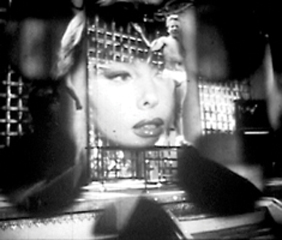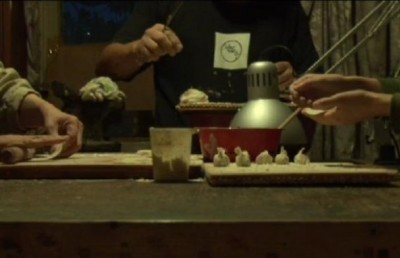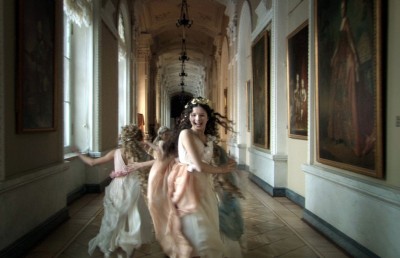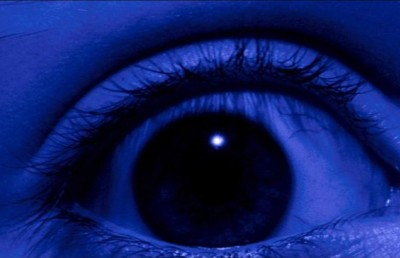Festival Nouveau Cinéma 2009:
The Long End of the Short
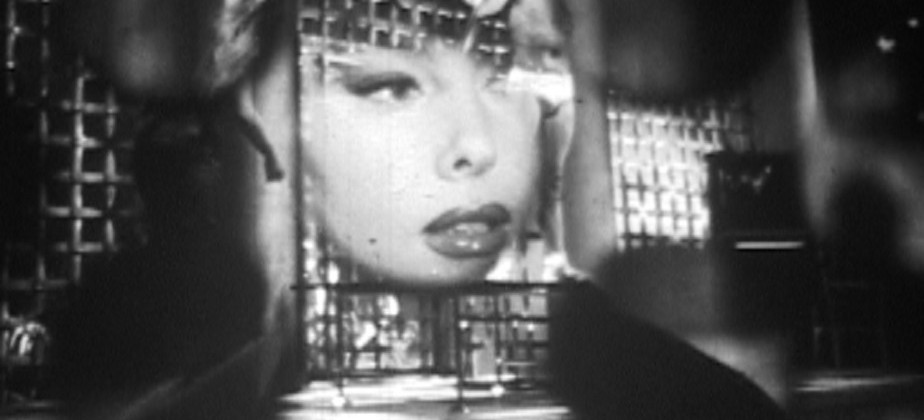
This year, as always, the Festival Nouveau Cinéma maintained its commitment to showcasing short films in all genres. A mixed bag is almost a necessity when you have no less than 20 programs dedicated to the short format, but there are always gems to be found, along with some illuminating frustrations. I submit for your consideration my (re)views on a baker’s dozen shorts culled from my festival schedule, each of which –in one way or another– managed to leave an indelible mark upon me.
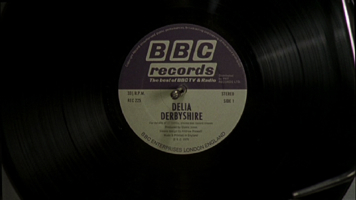
To begin on a high note, Concordia alumnus Kara Blake’s expertly crafted The Delian Mode examines the life and work of Delia Derbyshire, most well known as the electronic music pioneer responsible for realizing that most iconic of all TV theme songs: Dr. Who. This is one of those rare documentaries that is at once informational, aesthetically satisfying, and emotionally stirring – all in the space of 25 minutes! As a portrait of an eccentric genius, the film delves into the heart and mind of Derbyshire, a member of the BBC Radiophonic Workshop in the 1960s.
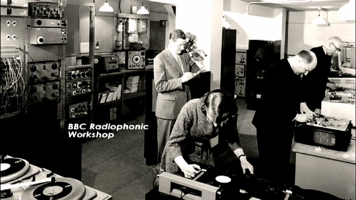
Consisting mostly of interviews with a range of people who either knew Derbyshire or who recognize the importance of her work, the film also boasts excerpts from a 1990s telephone interview with Derbyshire herself along with some choice archival footage of her in situ.
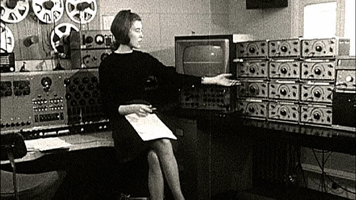
One of the things I like best about the film is that throughout its length Blake maintains an aesthetic that is lovingly committed to the visual details of the sound technologies that Derbyshire was so passionate about. A recurring motif suggests the similarity between phone lines and magnetic tape as we listen to Derbyshire’s voice on the telephone talking about her tape music process. Blake also skillfully blends archival material with newly shot inserts that help illustrate key points about Derbyshire’s work discussed by the various interviewees.
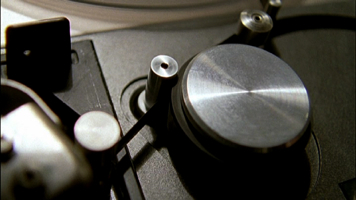
Included in this archival footage is a first-rate introduction to the tape-music process in the days before synthesizers and samplers. Derbyshire demonstrates how sounds are recorded on tape which can then be cut, looped, and speed adjusted to create new material. And since multi-tracking had yet to be invented, she illustrates how manipulated bits of tape can be layered by synchronizing a bank of individual tape players (praying that they remain in synch for the duration of the piece).
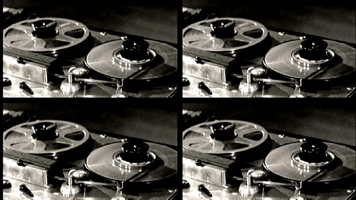
In the telephone interviews, conducted by Peter Kember of Sonic Boom, Derbyshire reflects upon her time at the BBC which, in retrospect, made up her golden years before departing in the 1970s to become something of a recluse. The film breaks up these interview segments with musical interludes in which we trace the evolution of her work while at the BBC, eventually leading to a recent collaboration with Kember that marked her return to musical productivity just prior to her untimely death early in the 21st century.
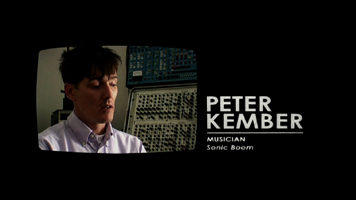
Amoung my favourite little details in the film is when Derbyshire describes her experience of the air raid sirens in London during the Blitz as “electronic music,” pure abstract sound whose source is unattainable to a child.
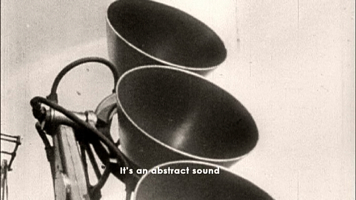
The film also raises an important issue in the world of electronic music that continues to be debated today: that of authorship associated with electronic instrumentation. Ron Grainer composed the Dr. Who theme on paper, but every sound you hear in the piece was created from scratch by Derbyshire. Grainer’s input consisted of notes on paper, but the profound effect of the piece is largely to do with Derbyshire’s inventiveness in the studio. Lord knows the piece would not have had the same effect if played through conventional symphonic instrumentation. In fact, one can hardly even imagine it that way. And Grainer himself recognized the value of Derbyshire’s contribution to the success of the piece, and was so pleased with the result he wanted Derbyshire to share credit as composer. However, the BBC rules stipulated that employees of their sound department could not receive credit any higher than “assistant”. Apparently the rules have since been changed, but too late for Derbyshire who could have made a substantial amount of money from her pioneering work.
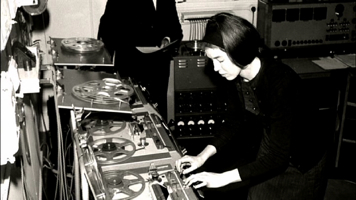
The film doesn’t dwell too long on what the emotional fall-out that this system of accreditation might have had on Derbyshire, but one can’t help but get the sense that her clear joy at work in the studio was stifled by the realities of the BBC’s bureaucracy, something she seemed unable to get over once she left the broadcaster. But the film ends on a high note. Derbyshire is in good spirits during her phone interviews, and along with news of her collaboration with Kember the film also points to the myriad ways in which Derbyshire’s work envisioned the technological realities that music producers are working with today. The last musical interlude presents a track that might be the earliest example of electronic dance music, and leaves us with a clear impression of Derbyshire’s pioneering spirit as it lives on today.
The film is packaged in a very refined presentation that I would describe as “BBC ready,” and I have no doubt this film will be picked up for television distribution in short order. And I also suspect that it will become canonical viewing in the classrooms of electroacoustic and electronic music programs around the world. This is easily the most well rounded documentary in the festival this year. My hat is off to Blake and her team.
Continuing with another portrait of an influential female musician, Jem Cohen’s Long for the City is the next in a long line of his meditations on Manhattan, this time through the eyes of legendary singer/songwriter Patti Smith. Jem Cohen is one of the most unique voices in contemporary cinema, with over two decades of work that fashions a style grounded in the particularities of small gauge experimental/documentary filmmaking while exploring the expressive potential of film’s marriage to video editing and post-production sound. Perhaps best known for his portraits of musicians in films like Instrument and Benjamin Smoke, in my mind he stands out as one of the cinema’s most accomplished practitioners of urban portraiture, much of his work revolving around his own experience of Manhattan. His lingering, lyrical, and contemplative super-8 and 16mm photography of New York City has left its mark on the landscape of contemporary American filmmaking. When Michael Almereyda decided to set his adaptation of Hamlet in the Big Apple, he hired Jem Cohen to shoot some of that film’s more memorable imagery of the city streets. Sam Mendes, on the other hand, was content simply to lift one of Cohen’s iconic shots from Lost Book Found – a plastic bag caught in a circular updraft – when he re-created that same scenario in the much-lauded American Beauty.
But more than capturing impressive images of the city, Cohen also engages with their complexity, with the problems and contradictions inherent in city life in general, and within New York City in particular. Lost Book Found is dedicated to Walter Benjamin (“Who Knew”) and noted Benjamin theorist Susan Buck-Morss (“Who Knows”). Indeed, the influence of Benjamin’s materialist approach to the history of urban space is clear in that film’s structure: a street vendor catches a glimpse of a mysterious book of lists created by an unknown author, lists that place objects in evocative categories that continue to haunt the narrator as he observes the city over the next several years. Confounded by the meaning of the illogical connections made within the book, the vendor searches for clues to these connections within his own experience of the city, a place where everything is connected but whose totality can never be comprehended. Since its appearance in 1996 I have been waiting for Cohen to return to the marvels of that film’s depth of archeological exploration of audiovisual relationships that forms a structure that mirror’s the narrator’s quest for the meaning of the lost book, a book found within the film’s own connection-making strategies with the pairing of sounds and images culled from Manhattan.
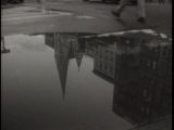
With this year’s very short Long for the City Cohen manages to delve back into the mysteries of a psychogeographic approach to Manhattan, this time structured around a conversation with Patti Smith about her own experience of the changing city. But instead of finding the city through the memory of a lost book, Smith describes how her city is being lost to her own memory of its past. “Taking a walk in New York City, I always see what I’m seeing, and I always see, at the same time, what I saw. And sometimes they merge perfectly…” while sometimes, they are split, “erased by progress, by death.” In her description of the layers of memory built up in her view of the city I find a likeness to the recent Mannahatta Project that attempts to map pre-European Manhattan onto the city of the present. They began with a map from the 1700s, and superimposed it onto a contemporary map via various points of intersection where spots on the old map continue to exist to this day. The project longs for the past, and invites people to walk around New York attempting to see what was once there but is now gone. Like the peanut vendor holding on to the memory of the lost book of lists, Smith sees in the city the connections to the past, but only to make the city that much more ephemeral.
But more than positing the new city in relation to its own past, Smith also positions the city in contrast to the countryside. To the extent that each can be glimpsed in the other, they are separate enough that to be in one can only lead to a longing for the other. “I’m a city person in terms of culture, coffee, architecture,” she says, “but I long for the sea, and the ghosts.” She continues, “If I had to choose, I think I’d choose the sea and long for the city.” And so, she says, “I guess the best thing I saw was the light rain.” The same rain that falls on the country, a tangible connection between the two, but only more mournful for being so. The wilderness that gave birth to NYC is gone, and can only be longed for.
And what of the wilderness of today that fuels the modern city? You would have to turn Manhattan inside out to get at the soil that was there before the Europeans arrived, so it is not without irony that the fuel for today’s urban civilization is often wrought from the wilderness turned inside out. Literally. Nowhere is this more apparent than in Canada’s own Albertan tar-sands, where it is not enough simply to drill for oil: vast tracts of wilderness need to be cleared, and the ground needs folded in on itself to release the bitumen oil/sand mix that can then be separated at a refinery. This is the process that Peter Mettler documents in Petropolis. The film is premised upon a simple idea: that the extent of the environmental destruction necessary to separate oil from sand is only comprehensible from the air. But this is not a perspective to which most of us have easy access. Filming images from the air and disseminating them through the media is a way of allowing the average person to view this situation from the necessary perspective. And yet, herein lies the conundrum: flying machines, cameras, and image receptacles are all products of the oil industry. This fact is not lost on Mettler who ends the film by musing about this very problem. So the film’s environmental goals, commissioned by Greenpeace, hover over the tension between the perils of our hunger for oil and the benefits of its products.
I have heard the film described as a Koyaanisqatsi for the 21st Century. While the scope of Petropolis is not equal to the Godfrey Reggio classic, it is very much in line with Reggio’s vision of a world out of balance. Indeed, Mettler borrows the classic structure of ??Koyaanisqatsi??’s opening act, beginning with aerial shots of a pristine wilderness before revealing humankind’s industrial footprint upon the landscape. We see a large smokestack in the distance, as Mettler takes us ever closer over lands that will eventually fall prey to the industry visible in the distance. And then, once we have arrived at ground zero, Mettler then zooms us back from the opposite angle, now revealing a devastated landscape that will eventually encroach upon the pristine wilderness that brought us here.
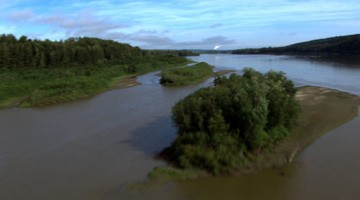
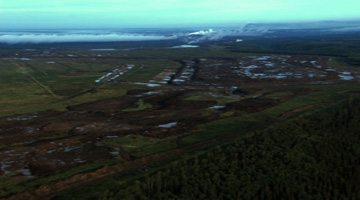
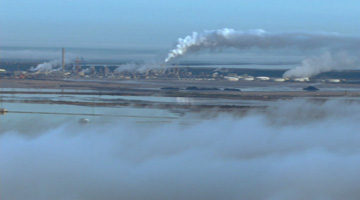
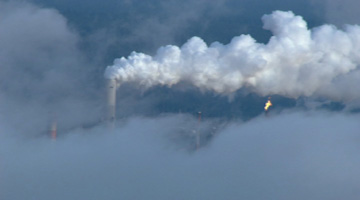
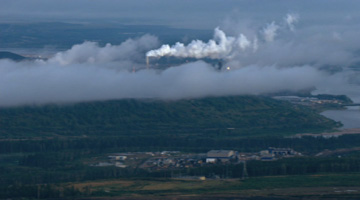
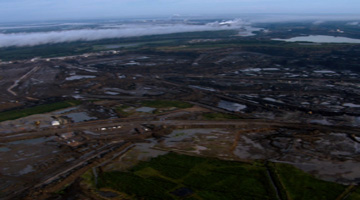
As a film, Petropolis is not what I would call the “full Mettler package” that we find in Picture of Light and Gambling, Gods, and LSD. Essentially, Petropolis is a Greenpeace vehicle for creating public awareness. But make no mistake: while the film’s questions aren’t as metaphysical or probing as those explored in the aforementioned films, and while Mettler’s aesthetics of audiovisual montage are not as prominent, Petropolis stands as a highly refined document with a powerful single-mindedness that allows one of Mettler’s greatest strengths to shine through: cinematography. This time shot in high definition digital video, Mettler’s attention to the textures of his chosen setting combined with the motion of the aircraft and a very subtle approach to cutting make this a very fine work indeed. Following on the thematic and aesthetic heels of his work as cinematographer on Manufactured Landscapes, and the questions of the presence of technology in the wilderness explored in detail in Picture of Light, Petropolis is a worthy entry in Mettler’s oeuvre. And one of the reasons the film hangs together so well is its approach to montage, handled by Roland Schlimme who is also credited along with Mettler for the sound design. A film like this, essentially based upon long takes with elegant movement, runs the risk of continually breaking the viewer out of its mesmerizing spell with each cut to a new perspective. Schlimme handles this problem with a keen eye for matching on texture and movement, rhyming the natural mist of the rainforest with the smoke of the bitumen upgrading plant, an associational montage that prompts questions about the interconnections between nature and industry.
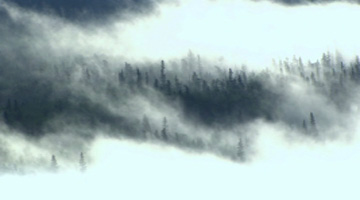
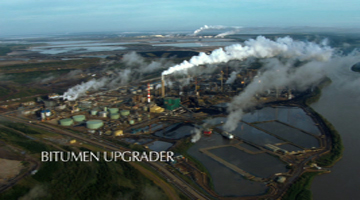
Meanwhile on the soundtrack we begin with the sounds of a temperate rainforest before a deep low frequency rumbling sets in, married with a pulsating heartbeat and increasingly artificial electronic tonalities that rise and fall with dramatic pans and zooms across the landscape, occasionally punctuating more pronounced camera movements and adjustments in exposure with synchronized sounds, calling attention to the presence of the filmmakers in a reflexive style that is an essential staple of Mettler’s approach to documentary filmmaking. The eerily beautiful electronic tonalities support the similarly strange aesthetic purity of this decidedly unnatural process. As such, the soundtrack continually keeps us aware of the alien nature of this industrial environment, even as we might fall prey to the majesty of its spectacle.
And so it is fitting that he ends the film by recounting the story of the world’s first hot air balloon flight, humanity’s initial foray into the world of the aerial perspective that has so changed our view of the world. He questions the technology that allows this perspective, the paradox that the most defining image of humanity – that of the Earth as seen from the Moon – is a function of the world’s most destructive thirst for technological progress that might eventually ensure that the world never looks the same again. For the moment, Mettler and Greenpeace bank on the power of these images to create greater good through public awareness than the harm caused by their use of technology. Indeed, when one witnesses the gigantic machines at work on the ground below Mettler’s camera, Mettler’s own technological footprint amounts to the plight of an ant beneath a Brontosaurus.
Where Petropolis provides perspectival insight into the source of oil that drives progress, and Long for the City laments the implementation of that progress within the constantly changing face of the modern city, The Solitary Life of Cranes takes a necessarily distanced view from the politics of industry and focuses on the daily life of construction crane operators in the heart of London. “Working in London without all that noise about you,” one operator observes, “it’s a totally different world.” And it is this different world that filmmaker Eva Weber focuses on: the distance from the ground, the aerial perspective, and the quiet.
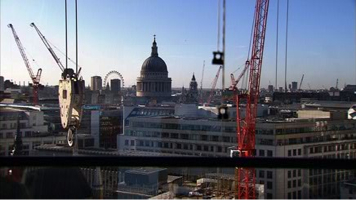
The film is an elegy to city life as perceived by one who is on the outskirts, an important part of the city’s ever-changing nature yet who is literally above it all. And not from a position of synoptic mastery, for the operators themselves are the first to admit their helplessness with regard to what they are in a unique position to observe, impotent gods with no control over their domain. Beautifully rendered, we watch a day in the life of a worker go by, from the “absolutely super” sunrise that opens the film to the lighting of the street lamps. Bits of audio interviews are woven together with airy ambient soundscapes infused with electronic tonalities, punctuating sounds of creaking cables and other articulations of the crane’s materiality, and radio broadcasts describing the state of the city on this particular day. Graced by the elegant motion of the cranes themselves, the camera provides gliding panoramic views over the city, peppered with intriguing camera angles that give us views through the crane box while emphasizing the operator’s anonymity and isolation.
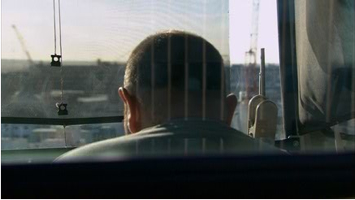
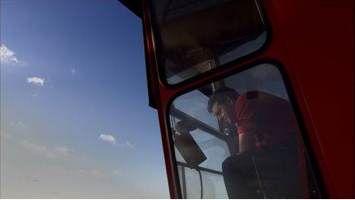
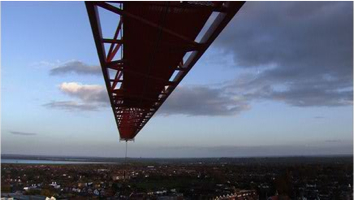
And in the end, this is the portrait that they paint of themselves, describing their ilk as separate from the generic construction worker pack, suffering some anxiety when called down to the site below to engage in communal labour when the crane is not needed. All they can think about is getting back up to the cab, of setting themselves apart from the world once again. And with the beauty of the film’s photography, one can easily see the appeal. In The Solitary Life of Cranes we find a refreshing approach to the city film, celebrated from a distance rather than from deep within its manic heart.
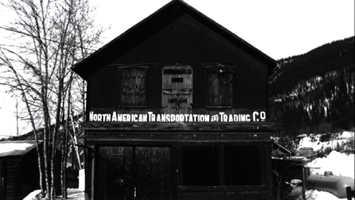
Another city celebrated from a distance is Canada’s own Dawson City, the subject of Deco Dawson’s Sluice Box and a Rocker. Only here the distance is provided by time rather than height. Through archival photographs, radio interviews, and footage of the town’s emptiness shot by Dawson in the present, the film describes the origins of the town during the gold rush and its eventual decay with a tone at once joyful and mourning. This tone is established through Dawson’s shot selection, lingering and desolate, paired with the sometimes vibrant descriptions of the town in its heyday that we hear on the soundtrack. The film’s dual tone is also aided a great deal by the use of material from Arvo Part’s Fur Alina which is becoming increasingly ubiquitous within the cinema (most notably in Gus Van Sant’s Gerry and Tom Tykwer’s Heaven). Here the icy music suits a landscape that many of its inhabitants were warned against, yet which nevertheless calls out with a certain irresistible quality. Sluice Box and a Rocker is a significant departure from Decco Dawson’s signature approach to eclectic montage work with Guy Maddin and in some of his own short films, but this film clearly demonstrates that Dawson can handle a slower pace as well as his more Eisensteinian efforts.
Venturing even further into the heart of nature, Trees of Syntax, Leaves of Axis –Daïchi Saïto’s second collaboration with violinist Malcolm Goldstein– is a remarkably visceral exploration of the textural relationships between the natural world and its hand-processed filmic representation. Where Petropolis, Cranes, and Sluice Box are each concerned with perspective (in one way or another), Trees is more about impressions marked as much by interiority as they are reflections of the world that appeared before Saïto’s lens. Consisting entirely of images of trees, these images pulsate stroboscopically as their colours and treatments grow increasingly elaborate.
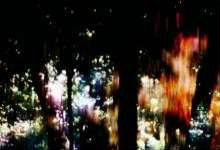
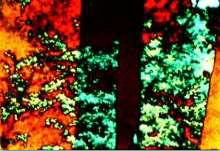
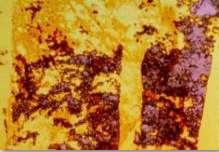
Yet the film doesn’t give way to total abstraction, wanting us to remain grounded in its natural roots so that we might see this material anew through the filmmaker’s handling of the material. Striking in its montage, the film is also notable for the predominance of centrally composed vertical trunks that frustrate any desire the viewer might have to see deep into the field, forcing us to concentrate instead on the brutal reality of the trees as a foreground plane, depth emerging from the processing rather than from the tyranny of perspectival photography. This stylistic approach creates an immediacy and urgency that is reflected by Goldstein’s remarkable improvised violin session. Recorded in a single take, Goldstein combines technical prowess and raw energy at once removed from the synchronization with the image but with a high level of energetic empathy, the grit of the bow on the strings finding corollaries in the grit of the speckled filmstock. Saïto deliberately avoided cutting the film to the soundtrack, preferring instead (as he did in their previous collaboration All That Rises) to create the image separately, trusting his knowledge of Goldstein’s work to lend itself well as a parallel universe to his images. And it works beautifully, the images of the trees still resonating in my mind’s eye like afterimages in complementary colours created by long exposure to stark contrast. I look forward to their next work.
While we’re on the subject of trees, one of the more bizarre entries in this year’s line-up was Up and About Again from Maarit Suomi-Väänänen.
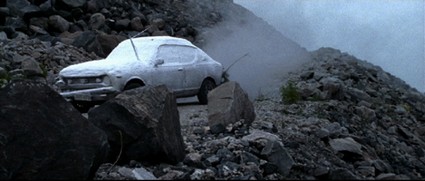
The film takes us on an absurdist journey following a snow-covered exhaust spewing Datsun as it moves from a barren rocky landscape through the remnants of civilization and on into a pristine forest in springtime. Along the way the car, whose windshield is totally obscured, winds down narrow paths, avoiding large boulders while being accosted by land mines (!) as it makes its way towards an uncertain destination.
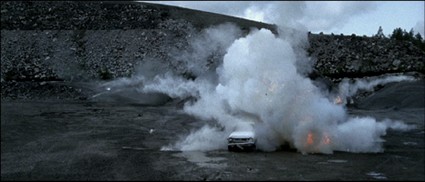
The first sign of civilization comes as the car happens upon an abandoned gas station where, in what may be a nod to the climax of Herzog’s Stroszek, it begins circling anarchically around the lot accompanied by a sudden outburst of punk music on the soundtrack.
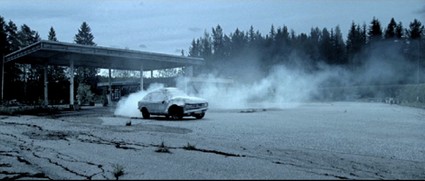
As the car goes about its business, the camera veers away, focusing on the smaller details of the landscape, from graffiti on the walls to lonely sprouts of vegetation emerging from the cracks in the pavement.
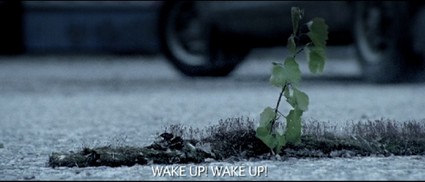
From here we transition to a lush green wood next to an overgrown tennis court, spring blossoms on the trees, damp moss hugging the bark all around. Enter the clunker, now losing a wheel and spewing furious blasts of smoke that lingers in the branches, a surreal image of the detritus of modern civilization seemingly out of place in a land that nature has reclaimed. And here our story ends as the car plugs relentlessly onwards to other landscapes we can only imagine.
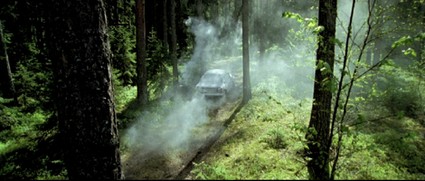
In the film’s clear three-part structure we thus move from a barren wasteland devoid of any life either human or vegetable, to a place where humans once were but have left, allowing for vegetation to creep back in, and finally to the unspoiled splendor of nature. What the vehicle’s objective is we never learn, except that it is on a journey that threads disparate spaces through a common object. While Suomi-Väänänen describes the film as something of a coming-of-age story, marked by blind birth, rebellious adolescence, and on into maturity, she also clearly revels in the film’s frustration of interpretation and genre classification. Indeed, she told me after the screening that it has been programmed in various classes from comedy to experimental, a fact that she sees as a sign of the film’s success. Whatever comment there may on the relationship between civilization and the natural world, the film is, above all else, a celebration of movement and delight in the details of mise-en-scène, with a (literally) explosive soundtrack that rocked the Fellini room at Ex-Centris like I haven’t heard for many a moon.
Now consider how strange it was to find Up and About Again in the same program as a 22 minute documentary on the obsessive relationship between black women and their hair. Indeed, the topic of Akosua Adoma Owusu’s My White Baby seems timely as Chris Rock’s own film on the topic was recently featured on Oprah who, in turn, is heard on Owusu’s soundtrack. Owusu paints a nuanced portrait of the extent to which black women treat their hair with exotic and painstakingly time consuming styles, while thinking about the relationship between this obsession and the processes of colonialization. The camera lingers on the myriad hair salons of the filmmaker’s hometown of Kumasi, Ghana, where women spend hours having their hair done. A woman recounts her experience as a young girl in Ghana, playing with the hair of white dolls discarded by the West, an exotic oddity in the context of an African country. When she moved to Canada, all of a sudden she was surrounded by white people, and would get in trouble for attempting to reach out and touch their hair without permission. “I was so happy to see all my dolls come to life” she says, a striking commentary on intercultural commodification.
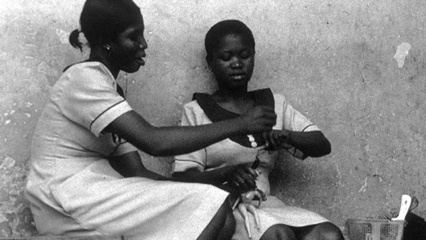
The film’s final shot is a remarkable super-slow-motion take of the film’s own author performing a double-pirouette with lengthy hair-extensions flying about. Turning a two-second event into a 2.5 minute shot through the use of a high-speed 16 mm camera, and married to an appropriately vintage funk track, the audience is enraptured by the marvels of hair as hair, positioned within a mise-en-scène that suggests a 70s disco or dance hall, her bejeweled necklace sending out periodic sparks of blazing light. Extending outwards with an almost 3D quality, this shot provides an aesthetic experience of the fetishization of hair that is the film’s subject, and is truly remarkable as such. The inclusion of this shot is interesting when considering the increasing proliferation of high-speed photography in the age of high definition digital video. Yet one of the reasons this shot stands out from nature photography or sports re-plays is for its remarkable texture paired with its sociological connotations. In that respect, it puts the languorous slow-motion prologue of Lars Von Trier’s Antichrist to shame, containing more profundity within a single unbroken take of a simple pirouette than all of Von Trier’s heavy-handed rendering of the fall of man and its connection to Freud’s primal scene. If there were an award for best single shot of the festival, this would have to win. But the weight of this shot depends as much upon the quality of the film’s preceding twenty minutes as on its own self-contained aesthetic perfection. As such it is an ideal conclusion to this story of hair as both an object of obsession and a marker of well-braided sociological interconnections.
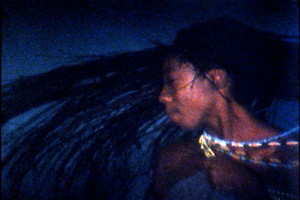
Finally, no edition of FNC would be complete without the requisite handful of forays into the world of found footage filmmaking. This year the focus of attention was on two rare feature-length found footage films: Film ist: A Girl and a Gun from Gustav Deutsch, and Double Take from Johan Grimonprez. And indeed, these were both remarkable in their own styles. A Girl and a Gun is the latest in Deutsch’s Film ist series, each operating as a kind of film essay, this time taking us on a positively divine tour through the little seen world of early 20th century pornography. The film is fashioned around a formal thrust that begins with the creation of the world through explosive volcanoes and other primal imagery, which then opens up into an extended reflection on love, sex, reproduction, and death, mediated largely by images of war as much as those of naked flesh. Though the film opens with a shot that literalizes its title, in this case Annie Oakley demonstrating her skeet shooting technique, this is actually a rarity.
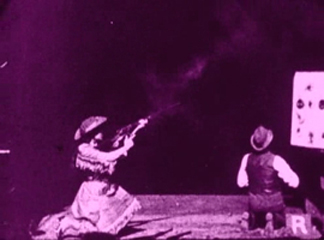
The rest of the film builds associations through montage, often in very funny ways – like a shot of explicit penetration being followed immediately by a man stuffing the barrel of a gun. Some critics have maligned the film’s heavy emphasis on the Freudian connection between sex and violence, finding it to be rather pedestrian in its loftier thematic aims. But the film’s great strength lies in its gestural approach to montage, rhyming shots based on figure movement and texture with a skill that is all too rare.
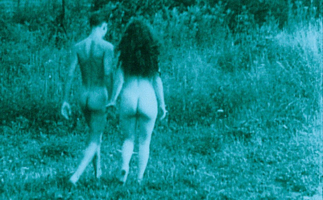
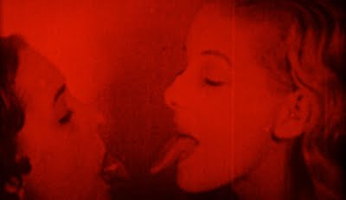
And in its presentation of a vast array of often obscure moments from a lost history of the cinema, it is a total immersion in the materiality of the medium’s early years, making for an excellent combination of choice selection and deft handling that is well worth the watch despite any misgivings about what Deutsch might actually be trying to say with this material.
Double Take is a very different beast, culling images from across Hitchcock’s career and blending them with cold war news footage and original material of a famous Hitchcock double shot by the filmmaker himself. While often very clever, the film’s seeming desire to create some form of commentary on Hitchcock’s personal and thematic relationship to cold war politics falls short of the mark. Focusing on Hitchcock’s obsession with the theme of doubling, the film seems to suffer from an exponential doubling of its own, simply following too many threads in too many directions until it is finally unable to pull them all together. Nevertheless, it’s a valiant effort and highly entertaining throughout. Definitely worth a watch.
In Holobomo, Owen Eric Wood questions the found footage genre, and our connection to cinema in general, in an inverted homage to Mike Hoolboom. Onscreen text at the film’s opening reads: “Sometimes it is difficult connecting to what I see, recycled experiences not my own.” Then we are confronted with myriad images that many of us recognize from canonical art films (by Lynch, Tarkovsky, and others), but which those familiar with Hoolboom will also recognize from his own found footage film, Imitations of Life. And so the film presents an interesting take on the found footage genre, a second-tier re-purposing of images that questions the goal of not only their previous recontextualization by Hoolboom, but also indeed their original meaning. Overwhelmed by the array of material presented in Images of Life, Wood stands in front of a movie screen, the images projecting onto his body as he reaches out to touch the screen, trying to connect but unable to penetrate the illusion.
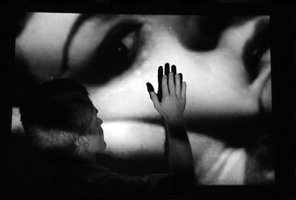
“There’s supposed to be some sort of story, some way to link all of these images, but nothing seems to fit together,” says Wood in voice-over narration. “And maybe that’s the story itself. Maybe things don’t fit together, at least not in any way that we can see.” And so, with this conclusion as his guiding strategy, Wood’s handling of this material is more of what you might call a de-purposing rather than a re-purposing, presenting the images ripped from their original context and stripped of their new home in Hoolboom’s film. Wood is commenting on the inaccessibility of Hoolboom’s approach to montage by setting the materials free to exist on their own, structured only to emphasize the lack of structure behind their compilation here. It’s an interesting approach, and Wood poses valid questions. But ultimately, for me at least, the experiment falls flat. Wood’s inability to connect with Hoolboom’s vision of the cinema is decidedly personal, and is different from my own response to Hoolboom’s film. Instead of trying to get inside Hoolboom’s idiosyncrasies, Wood simply collapses in front of them, overstimulated and unhappy for being so. Wood’s use of the same images leaves them empty. So we’re left with nothing but a general question about the ability of an audience to connect with a filmmaker’s vision, without any real substance.
The answer to Wood’s question is that yes, this material was meant to fit together in Hoolboom’s piece, in a way that reflects Hoolboom’s own connection to the material. Found footage is a way for people to connect with the material they’re exposed to, forging what John Oswald has called a two-way channel of cultural transmission that allows people to reclaim that which we have been exposed to rather than simply submit to the bombardment without engagement. Imitations of Life is Hoolboom’s exploration of this two-way cultural transmission. In Holobomo, Wood simply disrupts Hoolboom’s exercise in order to emphasize his own difficulty in accessing Hoolboom’s vision. In a way, Wood is blocking one side of the road, even as he exercises his own right to respond to the media in his own way.
This is certainly an interesting critique of the found footage process, but unfortunately the film ends up coming off as rather silly. The shtick of standing in front of the screen and trying to penetrate it is a useful illustration of Wood’s inability to connect with this material, but it leaves me thinking that his problem is with the distance inherent in the film/spectator relationship itself, and that he would prefer a virtual reality scenario where he could get inside the material and really live it. Either that, or he would prefer to live in the absence of images altogether, to premise community upon flesh and blood rather than reflected light. That’s fine for Wood, but there are those of us who enjoy what the cinema has to offer, and for whom found footage films offer a way of understanding cinema anew. Cinema, to me, is neither real life, nor a complete virtual world. It is, by necessity, incomplete. And this is why we can never fully access what we see on the screen, and that’s how it is meant to be. In recycling images into a work of found footage, filmmakers have the chance to connect with the material in ways that are impossible as a passive spectator. But in the end, the found footage film is just another film, also incomplete in its own way. Wood’s found footage approach questions the form, but offers little in the way of solution, and so he seems only to stand in the way of our appreciation of Hoolboom’s work as an appropriation artist. And so I say, “down in front!” I can’t see the movie with you standing in the way. Please, sit down, or exit the premises.
Where Owen Wood’s probing of the found footage form was at least thoughtful, the Dispersion Tapes from French newcomer Roxane Billamboz are rather devoid of intellectual consideration in their attempt at engaging with the rich history of the form. These tapes consisted of three short works concentrating on short loops subjected to digital manipulations. The festival guide suggests that these pieces constitute “an exploration of the use of digital software, a moving image where acceleration and repetition lead to illegibility and an evocation of human solitude that culminates in questions about communication” (p. 184). In this vein, the second piece, Repulsion: Faster, presents an excerpt from Polanski’s classic film, repeated over and over and faster and faster until it indeed becomes illegible. Another piece presents a shorter loop, a woman pivoting about to enter an elevator, repeated again over and over as the image grows increasingly abstract through various filtering treatments. But so what? Where is the benefit gained from seeing banal moments from this film repeated ad nauseum, faster and more abstract? I’m all for re-examining cinema by way of its own manipulation, but what is the result here? Repulsion: Faster doesn’t help us gather any particular insight into either Polanski’s film or the nature of film itself. A much richer example of a similar strategy would be Douglas Gordon’s 24 Hour Psycho that uses analog video technology to stretch Hitchcock’s original out to a much greater length, providing a space of reflection on both the original film and the nature of the moving image itself as mediated by way of video, here brought almost to a standstill that nevertheless moves relentlessly forward. Another clear antecedent would be David Rimmer’s Variations on a Cellophane Wrapper, in which the repeating gesture of a factory worker extending a roll of plastic towards the camera comments upon the industrial nature of the medium of film, while calling attention to the fact that in film viewing we are always looking through a coloured piece of plastic. The cellophane roll becomes a metaphor for cinema itself, and the view through the cellophane subjected to increasing filtering towards abstraction asks the viewer to acknowledge film’s materiality as a function of technological manipulation. Both Gordon and Rimmer’s films are the product of intense processing work of one variety or another whose weight can be felt in the density of the final films. This weight is absent in the point and click digital manipulations of these Dispersion Tapes.
Billamboz’s work might well illustrate the potential for digital technologies to manipulate film material, but they fall short of providing any interesting commentary or experiential import. While some may not see a difference between the basic principles at work between these tapes and their historical antecedents, I suggest that, in the digital age, manipulations that were once the product of laborious handwork can now be achieved with a few mouse clicks – and the result is an emptiness of form where there had been substance before. The intersection between film and digital technologies can indeed yield interesting results, but we have to go much further with it than resorting simply to loops, colouring, and speed adjustments, all of which I can replicate while viewing .avi files on my computer’s media player. Here Billamboz could take a cue from Delia Derbyshire, whose work prior to the digital age was nuanced enough to remain relevant even though new technology would now make the processes behind her work much more simple. This is the mark of a great artist pushing the envelope rather than simply creating methodological exercises for their own sake. In my opinion, the treatments evident in the Dispersion Tapes simply aren’t enough to warrant inclusion in a high-end showcase of experimental film like FNC. But obviously the programmers would disagree, and so I have an idea: perhaps for next year’s festival I’ll submit a copy of Gordon’s experimental limit case sped up by a factor of 12 and label it 24 Hour Psycho: Faster. Unless I miss my guess, the program committee should find this appealing. And whatever the public may think of my (lack of) authorial input, at least it would give people a chance to see the original Hitchcock classic on the big screen. Perhaps that wouldn’t fit the category of “new cinema” after which the festival is named, but there is nothing new about these Dispersion Tapes either.
Thankfully, I can end this report as it began: on a high note. One of the gems of the year was Richard Kerr’s De Mouvement, which, it turns out, is very aptly titled. Although it follows from his previous Collage d’Hollywood in its use of film trailers as source material, the re-purposing here is less about overt commentary on the spectacle of the trailer format (and the Hollywood movies they advertise), concentrating instead on skillful montage around specific points of movement. Using trailers predominantly from 1950s black and white French films, Kerr deftly navigates around gestures, camera movements, and most significantly, the pronounced wipes and other overtly visible transition techniques that were popular in the era. Where Collage d’Hollywood made extensive use of multiple layers of superimposition that made the actual cutting of the film rather invisible, here the art of montage is rendered highly transparent as the wipes are multiplied and compounded, the film threatening to break apart at the seams at any moment. Our journey through this material is highly fragmentary, like following a pair of scissors as they angle their way through a piece of folded paper in search of a snowflake pattern. The statement here is not as bold as in Collage d’Hollywood, with its emphasis on repetition and speed, pushing the material to the point of total abstraction as a poignant form of social critique. Instead, the joy in De Mouvement comes from keeping the material relatively in tact so that the angularity of the montage can shine through all the more brightly. In Collage d’Hollywood I would have liked the highly textured treatments of the film materials to be matched by the soundtrack, and my critique of De Mouvement is the same. While the sound designers are different on each project, they share a contemporary digital slickness that betrays the dated materiality of the images and their manipulation by hand. Perhaps if more of the sound material was culled from the trailers themselves and treated more like Kerr’s approach to visual montage then the two would harmonize more concretely. Nevertheless, the film stands as a testimony to Kerr’s continuing interest in re-invigorating lost materials through extensive recycling and montage work. In his introduction to the film he humbly suggested that his reason for continuing to make films is to remain relevant to his students, but I believe his contribution to the found-footage form can stand with established masters of the genre as well as act as inspiration to its next generation.
